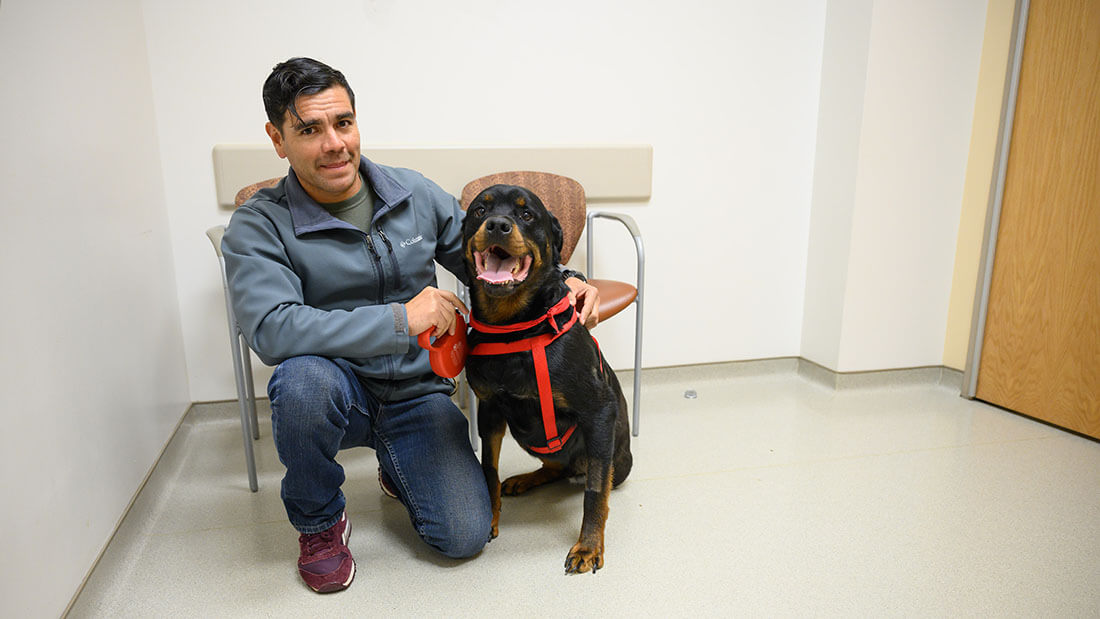When Being on Trial is Good

For a dog, 4-year-old Rottweiler Mick Roca is a real pussycat.
“He likes to make friends. He’s very friendly to dogs, to kids — everybody,” says Jorge Roca. “He likes kids a little too much. He gets excited and jumps.”
Jorge Roca is an 11-year veteran of the U.S. Army currently stationed at Fort Bragg, where he is an engineer. He has been deployed overseas, including tours in Iraq and Afghanistan. He and his wife, Teresa, have three daughters and a son, and in 2015 they added Mick. The dog was actually a gift to one of their daughters, who picked him out. Roca said he was a bit taken aback when she chose a Rottweiler, but Mick has been a great addition to the family.
This summer the Rocas noticed Mick limping on his left rear leg. When it didn’t clear up as the summer went on, the Rocas grew more concerned. Eventually, the dog would lift his leg completely, not putting any weight on it at all. That’s when they took Mick to see a veterinarian.
It was more serious than they imagined. Mick had osteosarcoma, a malignant tumor of the bone in the lower leg near the knee joint. The problem was diagnosed in September by Mick’s primary care veterinarian, and in October his left hind leg was amputated.
Osteosarcoma is the most common bone cancer in dogs, and is extremely aggressive, often spreading to other parts of the body, especially the lungs. Numerous peer-reviewed published studies have found that more than 90% of dogs with osteosarcoma have microscopic presence of the disease already in their lungs by the time they are diagnosed. The long-term outlook for these dogs is poor, and additional treatment is necessary to slow the disease’s progress.
Mick was referred to the NC State Veterinary Hospital’s oncology service. There, the Rocas learned that the median survival time for dogs with osteosarcoma who are treated with surgery alone is just three to six months, while surgery followed by chemotherapy or radiation improved survival times to 10 to 12 months. It was sobering information for the family.
That was when they were told about a clinical study conducted by Michael Mastromauro, CVM assistant clinical professor of medical oncology. The trial involves a treatment called total lung irradiation, which is used in conjunction with chemotherapy. A low dose of radiation is delivered to the lungs for the purpose of killing microscopic cancer cells.
Mastromauro points out that there are no previous studies testing the effectiveness of combining total lung irradiation with standard amputation and chemotherapy treatments. This will be the first systematic test of this therapeutic approach in veterinary medicine.
Pet owners who are interested in participating in this clinical trial can find more information at https://cvm.ncsu.edu/research/clinical-trials.
This approach to Mick’s treatment involves a variety of expenses plus frequent trips back and forth from Fayetteville for the Rocas. On one hand it is an attractive option, since it offers the possibility of improving Mick’s survival chances. On the other, as Jorge Roca points out, “we have four kids at home, including one in college, and the economics are a concern. But we’re willing to do whatever Mick needs.”
Fortunately, the Petco Foundation and Blue Buffalo Cancer Treatment Fund is making that possible. It is for owners like Roca that the Petco Foundation and Blue Buffalo have created cancer treatment funds at leading veterinary hospitals like NC State. The treatment funds help owners like Roca defray the cost of treating companion animal cancers. These generous investments help pet parents focus on providing the best possible care for their pets rather than the cost of care.
“When we found out about the Petco Foundation and Blue Buffalo Cancer Treatment Fund, it was an exciting day for us,” Jorge Roca says. “Everybody treating him has been really great. It’s nice to be able to know your dog is well taken care of.”
Best of all, Mick is responding well to the treatments.
“He was even running last week,” Roca says. “It was great to see him look the same and want to play. We know this is a gamble. But we hope for the best. Seeing Mick feel better, it’s worth it.”
- Categories:


